This pub is the former Wyndham Hotel, originally the Wyndham Arms of 1792, named after a centuries-old local family.
Photographs and text about the Vale of Glamorgan Railway.
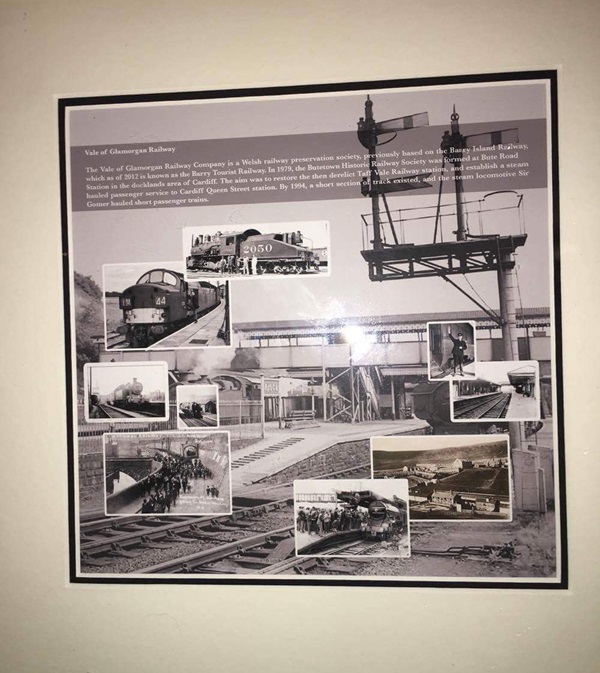
The text reads: The Vale of Glamorgan Railway Company is a Welsh railway preservation society, previously based on the Barry Island Railway, which as of 2012 is known as the Barry Tourist Railway. In 1979, the Butetown Historic Railway Society was formed at Bute Road Station in the docklands area of Cardiff. The aim was to restore the then derelict Taff Vale Railway station, and establish a steam fuelled passenger service to Cardiff Queen Street station. By 1994, a short section of track existed, and the steam locomotive Sir Gomer hauled short passenger trains.
Prints and text about Bridgend/ Penybont.
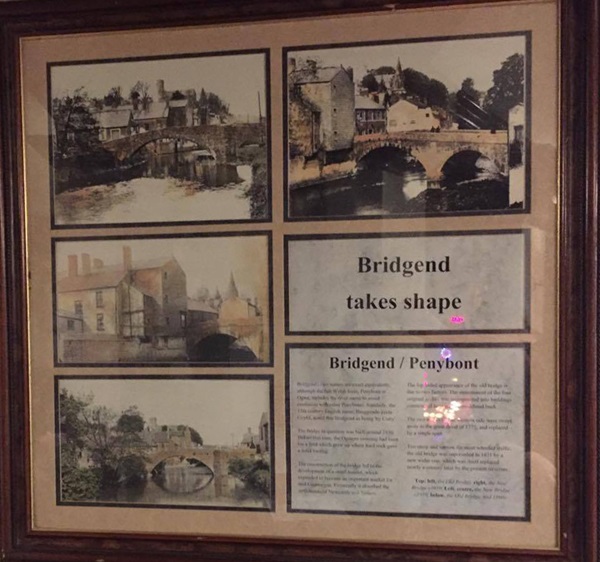
The text reads: Bridgend’s two names are exact equivalents, although the full Welsh form Penybont ar Ogwr, includes the river name to avoid confusion with other Penybonts. Similarly, the 15th century English name, Bruggende-juxta-Coytif, noted this Bridgend as being ‘by Coity’.
The bridge in question was built around 1430. Before that time, the Ogmore crossing had been via a ford which grew up where hard rock gave a solid footing.
The lop-sided appearance of the old bridge is due to two factors. The easternmost of the four original arches was incorporated into buildings constructed later on a consolidated bank.
The two arches on the western side were swept away in the great flood of 1775, and replaced by a single span.
Too steep and narrow for most wheeled traffic, the old bridge was superseded in 1821 by a new wider one, which itself was replaced nearly a century later by the present structure.
Top: left, the Old Bridge, right, the New Bridge c1910
Left, centre, the New Bridge c1910, below, the Old Bridge, mid 1960s.
Prints and text about the Wyndham Hotel.
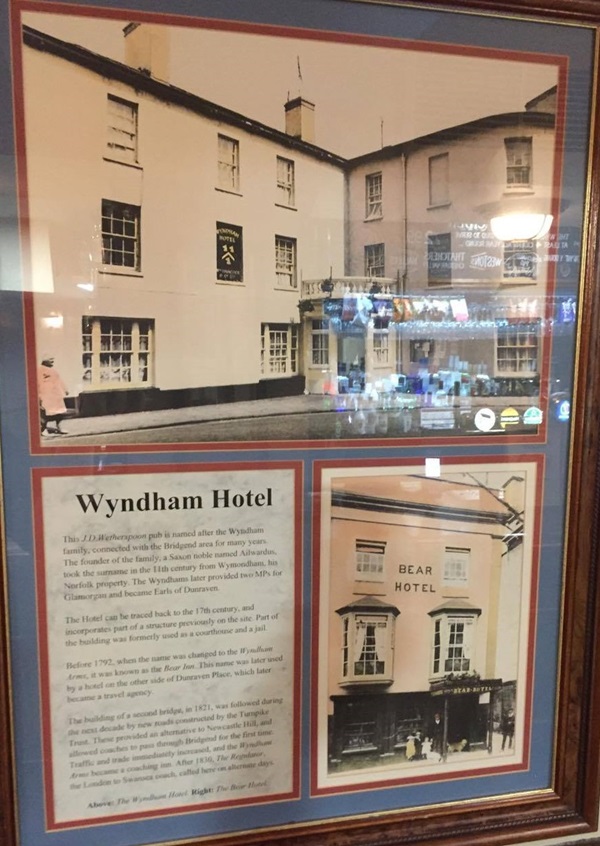
The text reads: This J D Wetherspoon pub is named after the Wyndham family, connected with the Bridgend area for many years. The founder of the family, a Saxon noble named Ailwardus, took the surname in the 11th century from Wymondham, his Norfolk property. The Wyndhams later provided two MPs for Glamorgan and became Earls of Dunraven.
The hotel can be traced back to the 17th century, and incorporates part of a structure previously on the site. Part of the building was formerly used as a courthouse and a jail.
Before 1972, when the name was changed to the Wyndham Arms, it was known as the Bear inn. This name was later used by a hotel on the other side of Dunraven Place, which later became a travel agency.
The building of a second bridge, in 1821, was followed during the next decade by new roads constructed by the Turnpike Trust. These provided an alternative to Newcastle Hill, and allowed coaches to pass through Bridgend for the first time. Traffic and trade immediately decreased, and the Wyndham Arms became a coaching inn. After 1830, the regulator, the London to Swansea coach, called here on alternate days.
Above: The Wyndham Hotel
Right: The Bear Hotel.
An illustration and text about Ewenny Priory and JMW Turner.
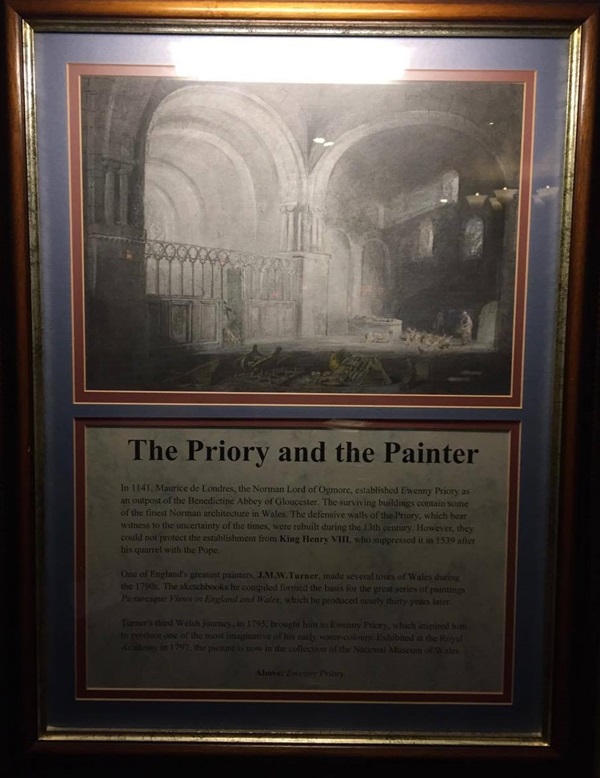
The text reads: In 1411, Maurice de Londres, the Norman Lord of Ogmore, established Ewenny Priory as an outpost of the Benedictine Abbey of Gloucester. The surviving buildings contain some of the finest Norman architecture in Wales. The defensive walls of the priory, which bear witness to the uncertainty of the times, were rebuilt during the 13th century. However, they could not protect the establishment from King Henry VIII, who suppressed it in 1539 after his quarrel with the Pope.
One of England’s greatest painters, JMW Turner, made several tours of Wales during the 1970s. The sketchbooks he compiled formed the basis for the great series of paintings Picturesque Views in England and Wales, which he produced nearly thirty years later.
Turner’s third Welsh journey in 1975, brought him to Ewenny Priory, which inspired him to produce one of the most imaginative of his early watercolours. Exhibited at the Royal Academy in 1797, the picture is now in the collection of the National Museum of Wales.
Above: Ewenny Priory.
Illustrations of Ewenny Priory.
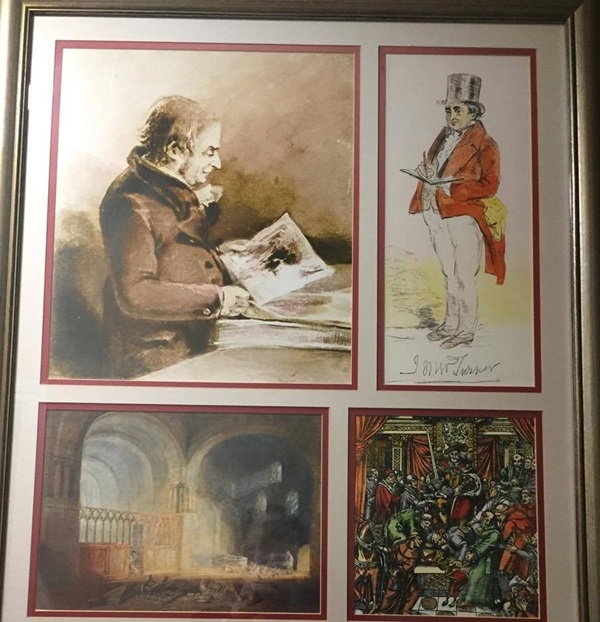
Illustrations and text about the red dragon of Wales.
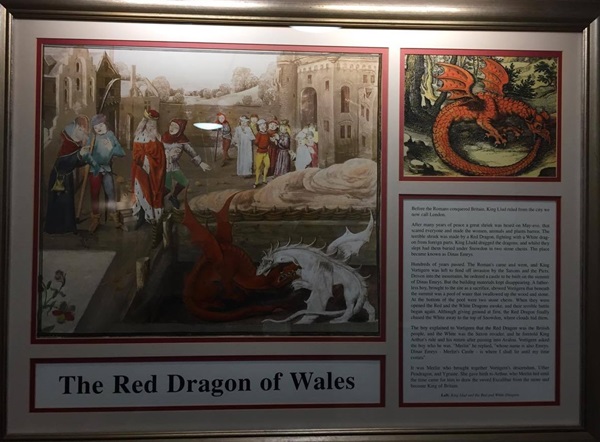
The text reads: Before the Romans conquered Britain, King Llud ruled from the city we now call London.
After many years of peace a great shriek was heard on May-eve that scared everyone and made the women, animals and plants barren. The terrible shriek was made by a red dragon, fighting with a white dragon from foreign parts. King Llud drugged the dragons, and whilst they slept had them buried under Snowdon in two stone chests. The place became known as Dinas Emrys.
Hundreds of years passed. The Romans came and went, and King Vortigern was left to fend off invasion by the Saxons and the Picts. Driven into the mountains, he ordered a castle to be built on the summit of Dinas Emyrs. But the building materials kept disappearing. A fatherless boy, brought the site as a sacrifice, showed Vortigern that beneath the summit was a pool of water that swallowed up the wood and stone. At the bottom of the pool were two stone chests. When they were opened the red and white dragons awoke, and their terrible battle began again. Although giving ground at first, the red dragon finally chased the white to the top of Snowdon, where clouds hid them.
The boy explained to Vortigern that the red dragon was the British people, and the white was the Saxon invader, and he foretold King Arthur’s rule and his return after passing into Avalon. Vortigern asked the boy who he was. “Merlin” he replied, “whose name is also Emrys. Dinas Emrys – Merlin’s Castle – is where I shall lie until my time comes”.
It was Merlin who brought together Vortigern’s descendants, Uther Pendragon and Ygraine. She gave birth to Arthur, who Merlin hid until the time came for him to draw the sword Excalibur from the stone and become King of Britain.
Left: King Llud and the red and white Dragons.
Prints and text about local landowners.
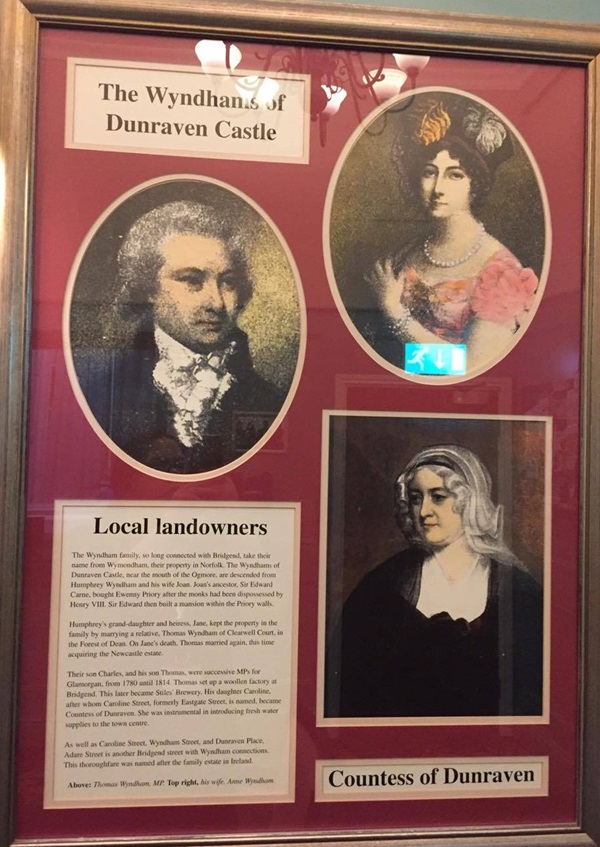
The text reads: The Wyndham family, so long connected with Bridgend, take their name from Wyndmondham, their property in Norfolk. The Wyndhams of Dunraven Castle, near the mouth of the Ogmore, are descended from Humphrey Wyndham and his wife Joan. Joan’s ancestor, Sir Edward Carne, bought Ewenny Priory after the monks had been dispossessed by Henry VIII. Sir Edward then built a mansion within the priory walls.
Humphrey’s granddaughter and heiress, Jane, kept the property in the family by marrying a relative, Thomas Wyndham of Clearwell Court, in the Forest of Dean. On Jane’s death, Thomas married again, this time acquiring the Newcastle estate.
Their son Charles, and his son Thomas, were successive MPs for Glamorgan, from 1780 until 1814. Thomas set up a woollen factory at Bridgend. This later became Stiles’ Brewery. His daughter Caroline, after whom Caroline Street, formerly Eastgate Street, is named, became Countess of Dunraven. She was instrumental in introducing fresh water supplies to the town centre.
As well as Caroline Street, Wyndham Street, and Dunraven Place, Adare Street is another Bridgend street with Wyndham connections. This thoroughfare was named after the family estate in Ireland.
Above: Thomas Wyndham, MP
Top right, his wife, Anne Wyndham.
Prints and text about the Wyndham Arms.
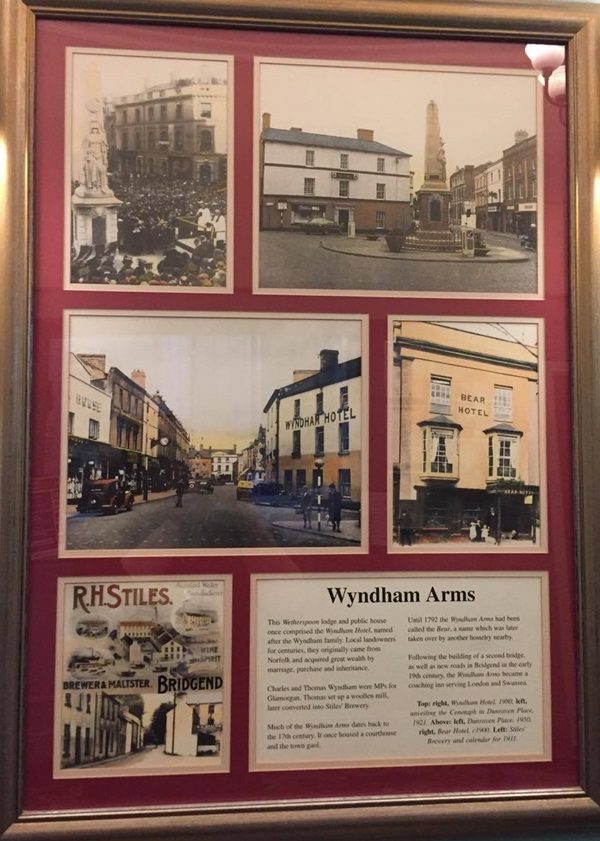
The text reads: This Wetherspoon lodge and public house once comprised the Wyndham Hotel, named after the Wyndham family. Local landowners for centuries, they originally came from Norfolk and acquired great wealth by marriage, purchase and inheritance.
Charles and Thomas Wyndham were MPs for Glamorgan. Thomas set up a woollen mill, later converted into Stiles’ Brewery.
Much of the Wyndham Arms dates back to the 17th century. It once housed a courthouse and the town gaol.
Until 1972 the Wyndham Arms had been called The Bear, a name which was later taken over by another hostelry nearby.
Following the building of a second bridge, as well as new roads in Bridgend in the early 19th century, the Wyndham Arms became a coaching inn serving London and Swansea.
Top: right, Wyndham Hotel, 1980, left, unveiling the Cenotaph in Dunraven Place, 1921
Above: left, Dunraven Place, 1950, right, Bear Hotel, c1900
Left: Stiles’ Brewery and calendar for 1911.
External photograph of the building – main entrance.
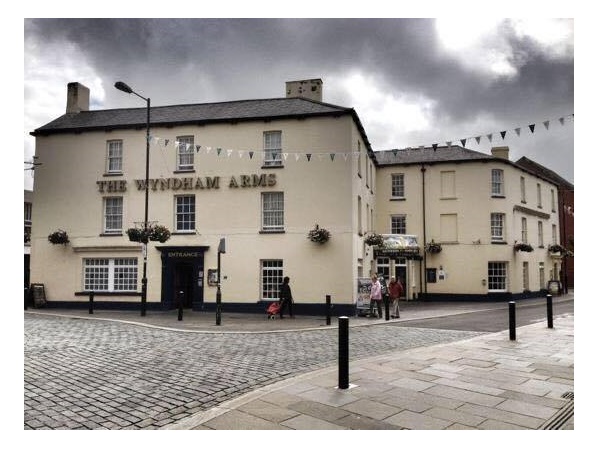
If you have information on the history of this pub, then we’d like you to share it with us. Please e-mail all information to: pubhistories@jdwetherspoon.co.uk